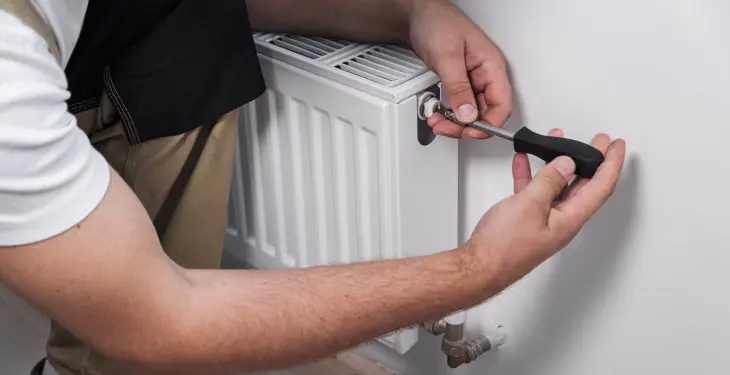
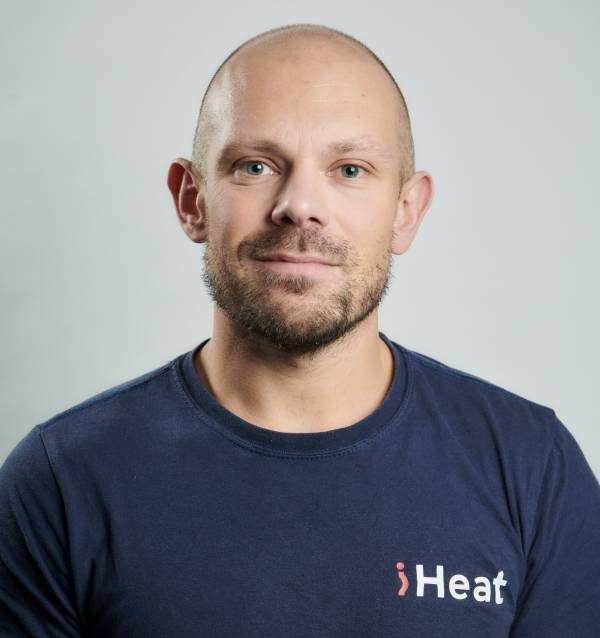
Written by Stephen Day
Gas Safe Engineer
Updated: 12th December, 2025
You bleed a radiator by turning off the heating, opening the bleed valve and releasing trapped air until water flows steadily.
Get a new boiler quote, save up to £550 per year (0% APR available).
Bleeding a radiator releases trapped air that has collected inside the heating system.
When air sits at the top of a radiator, the hot water cannot circulate properly. This leaves the bottom warm and the top cool or completely cold.
Releasing air restores full circulation so the radiator heats evenly again.
Homeowners carry out this task regularly because small amounts of air can build up over time as water moves around the system.
Air can also enter after any work involving pipework or pressure changes.
At iHeat we see this issue often. Many customers report uneven radiators in autumn as they switch the heating back on.
Air naturally rises through the system which is why radiators on upper floors tend to need bleeding more frequently.
A radiator does not always stop working completely when it contains air.
Most warning signs are mild at first, including:
Warm at the bottom but cold at the top
Gurgling, hissing or bubbling noises
Radiators taking longer than normal to heat up
A drop in boiler pressure after you bleed multiple radiators
If one radiator has air, others may follow. Checking the whole system takes only a few minutes and often restores full heating performance without further work.
If your radiator still stays cool at the top after bleeding, our guide on radiators not heating up explains the other common causes to check.
Air can enter a heating system in several ways.
These causes are well known in domestic heating and are routinely identified during engineer servicing:
Small gaps in older joints or valves
Frequent topping up of the system which introduces fresh water containing dissolved air
Pressure loss that allows new air to enter
Recent works such as pipe repairs, radiator replacement or pump changes
Long periods where the heating has been turned off
Understanding why air builds helps homeowners notice patterns.
For example, it is common to find air in radiators that sit on higher floors because air rises naturally through heated water.
Bleeding radiators is a safe task for homeowners as long as the instructions are followed carefully. You only need:
A radiator bleed key
A cloth or small container to catch any drips
A pressure gauge on the boiler that you can read easily
You do not need to touch anything inside the boiler.
Only a qualified engineer should open the boiler casing or work on internal parts.
The process is simple and normally takes less than five minutes per radiator.
The steps below follow safe practice for sealed central heating systems used across the UK.
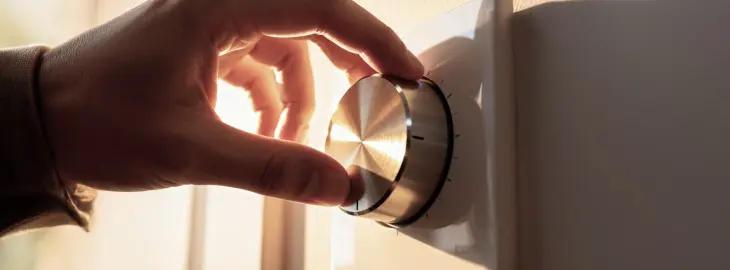
This protects you from hot water escaping and helps air rise to the very top of the radiator.
Cooling usually takes around twenty minutes.
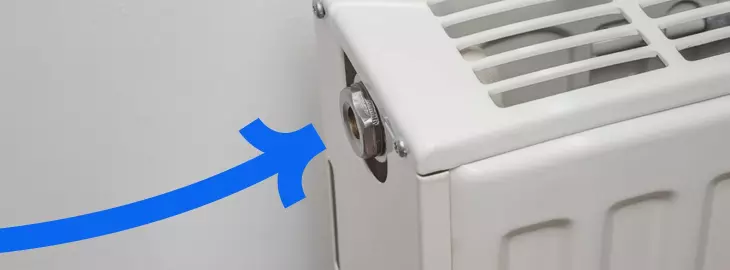
This is a small square or slotted fitting usually at the top corner of the radiator.
Place a cloth underneath before opening it.
If you are unsure how the bleed valve works, our radiator bleed valves explained guide provides a simple breakdown.
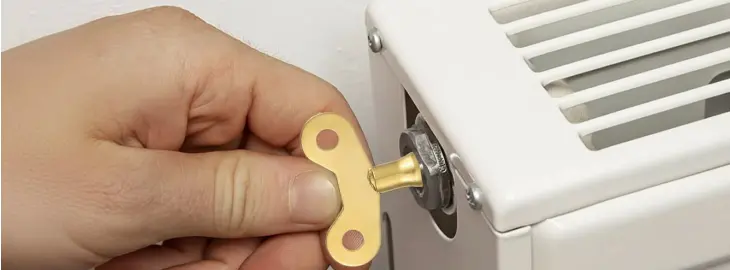
Turn the bleed valve anticlockwise. You will hear air hissing out.
Keep the valve open only until water starts to appear.
Once water appears, close the valve firmly by turning clockwise.
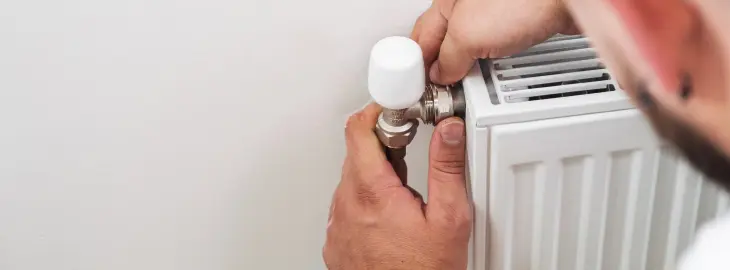
Start with radiators on the ground floor and work your way up.
Air often settles in higher radiators so you may hear more hissing as you move upward.
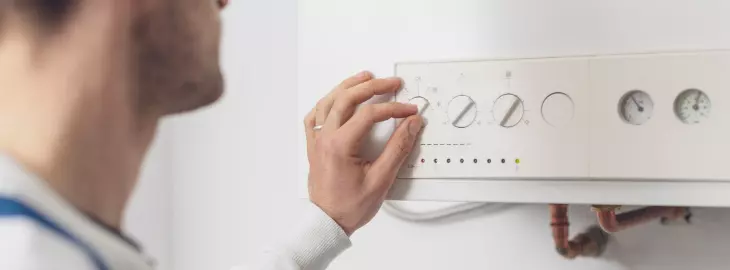
After bleeding, the system loses a small amount of water which lowers the pressure.
Most boilers operate safely around 1.0 to 1.5 bar when the system is cold.
If your pressure has dropped below this range, the system needs topping up using the filling loop.

Allow the system to run.
The radiators should now warm up evenly with no gurgling.
Bleeding radiators and boiler pressure always work together.
A sealed heating system needs the correct pressure to move water through radiators.
If pressure is too low, the boiler may fail to start or may show a low pressure warning.
Most boilers sit between 1.0 and 1.5 bar.
Pressure rises naturally. Anything up to around 2.0 bar is typical.
If pressure drops below 1.0 bar after bleeding, top it up using the filling loop until it returns to approximately 1.2 bar. Increase slowly to avoid overshooting.
Do not keep topping up the boiler every few days, as this can point to a deeper issue that needs attention.
Even though bleeding radiators is straightforward, these points help avoid common issues:
Do not overbleed. Once water comes out, stop immediately.
Do not open the boiler casing. This is for engineers only.
Do not ignore repeated pressure drops, as they can indicate leaks or failing components.
Do not bleed radiators with the heating switched on. This risks hot water escaping.
Do not force a stiff valve. If it will not turn, an engineer can free it safely.
If your system continues to lose pressure after bleeding, our boiler losing pressure guide covers the most likely causes.
Bleeding radiators fixes the majority of circulation issues, but certain conditions require professional attention.
A Gas Safe engineer should inspect the system if:
Pressure keeps dropping after topping up
Radiators fill with air again soon after bleeding
You hear ongoing banging, tapping or knocking
Some radiators stay cold even after several attempts
The boiler shows repeated pressure or circulation fault codes
You cannot turn the bleed valve without risk of damage
Persistent air problems often indicate issues such as a failing pump, a pressure vessel losing charge, or a leak somewhere in the system.
These require trained diagnosis and should not be repaired by a homeowner.
Small steps help prevent air from entering the system and reduce how often you need to bleed radiators:
Check boiler pressure once a month
Bleed radiators at the start of every heating season
Have your boiler serviced annually
Keep an eye out for white residue or damp patches around joints
Avoid overfilling the system when topping up pressure
These actions keep circulation smooth and help the boiler work at peak efficiency.
If you have noticed rising heating costs this winter, our high energy bills guide explains how radiator performance and system efficiency are linked.
If your radiators still do not heat evenly after bleeding or if the boiler pressure will not stay stable, iHeat can help.
Our Gas Safe engineers diagnose heating and circulation problems every day, working with leading brands including Worcester Bosch, Vaillant and Ideal.
We offer clear advice, safe repairs and fast appointments to restore reliable heating in your home.
Last updated: 12th December, 2025

Written by Stephen Day
Gas Safe Engineer at iHeat
Stephen Day is a Gas Safe registered and FGAS certified engineer with over 20 years of hands-on experience in the heating, cooling, and renewable energy industry, specialising in boiler installations, air conditioning, and heat pump systems.
LinkedInArticles by Stephen Day are reviewed by iHeat’s technical team to ensure accuracy and reliability.
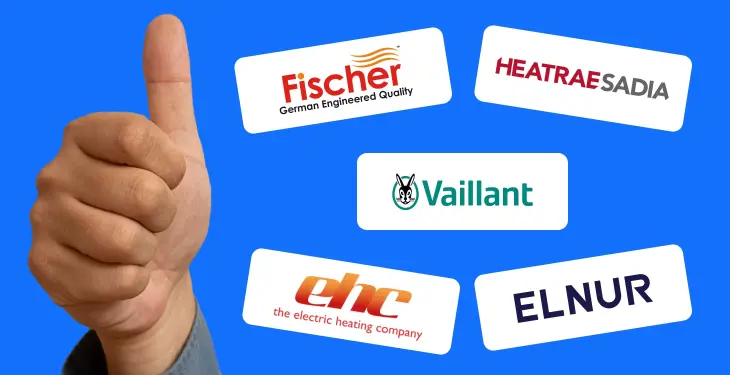
12th December, 2025
The best electric combi boilers in 2025 include models from Electric Heating Company, Heat...
 Read Article
Read Article

12th December, 2025
The Vaillant F22 fault means your boiler pressure is too low and needs topping up.
 Read Article
Read Article

12th December, 2025
A combi boiler should be around 1.0 to 1.5 bar when cold and up to about 2.0 bar when hot.
 Read Article
Read Article
No obligation. Takes less than 60 seconds.